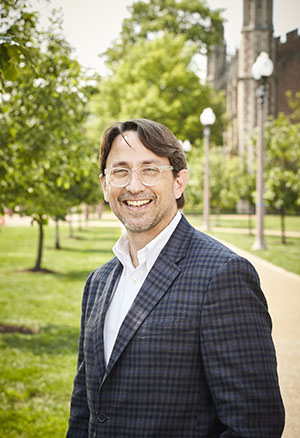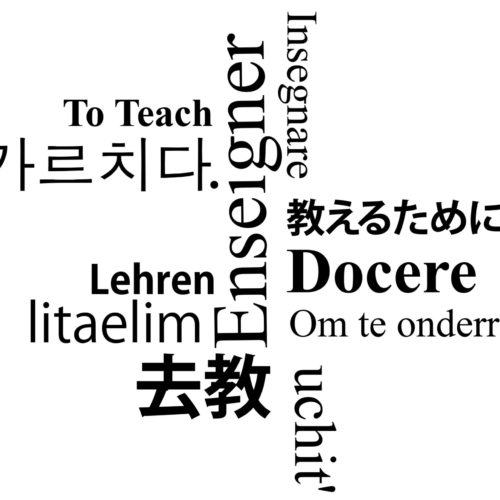Theatre Professor Emphasizes Student Creativity in Learning
 “You can’t take a student where they want to go, but you can show them the way. College is the beginning of that journey,” said Robert Mark Morgan, Teaching Professor in the Department of Performing Arts at Washington University in St. Louis and Director of the Beyond Boundaries Program. Morgan teaches set design classes and leads Beyond Boundaries, an interdisciplinary two-year program that allows students to pursue paths of intellectual inquiry that do not fit within traditional subject matter boundaries.
“You can’t take a student where they want to go, but you can show them the way. College is the beginning of that journey,” said Robert Mark Morgan, Teaching Professor in the Department of Performing Arts at Washington University in St. Louis and Director of the Beyond Boundaries Program. Morgan teaches set design classes and leads Beyond Boundaries, an interdisciplinary two-year program that allows students to pursue paths of intellectual inquiry that do not fit within traditional subject matter boundaries.
Morgan also co-teaches a popular undergraduate course, “Designing Creativity,” which he launched in 2015 with Bruce Lindsey, E. Desmond Lee Professor for Community Collaboration at the Sam Fox School of Design & Visual Arts at Washington University in St. Louis. The class is divided into seven two-week sessions that explore different topics on creativity through lecture, discussion, and guest speakers.
Morgan earned a B.F.A. in set design from Webster University in St. Louis. He completed graduate studies in set design at San Diego State University. Throughout his career, Morgan has designed sets for numerous theatres including the Denver Center for the Performing Arts, The Repertory Theatre of St. Louis, and the former San Jose Repertory Theatre. Prior to his position at Washington University in St. Louis, he held teaching positions at the University of California, Berkeley, and the University of Washington in Seattle.
In an interview with the Teaching Center, Morgan emphasized the value of uninhibited academic exploration. He also discussed how creating a safe classroom environment can benefit student learning and inquiry.
How did you get involved in set design?
My first year of high school, a woodshop class closed early that I wanted to be in. My friend told me there was a technical theatre class we could sign up for instead. I took it and I was hooked. I loved the collaborative aspect of the art form and the thrill of putting on a show and being a part of it behind the scenes.
About halfway through my undergraduate studies in stage management at Webster University in St. Louis, I decided that I didn’t want to do it. I wanted to be a designer. I liked building models and being an architect for the stage.
How did you transition from full-time set design to full-time teaching?
The first time I started teaching was by mistake. I was working at the Denver Center for the Performing Arts, and I’d spend late nights and weekends in the design studio working on my own projects. One time late at night, a tour of patrons came through. Normally, the docent would ask me to give a spiel about what I did, and then the group would go on to the costume shop. This time, one guy stayed behind. He taught film at the Art Institute of Colorado. He told me that his students put together films without thinking about surroundings or art direction. He asked me if I wanted to teach a class on art direction. He talked me into doing it.
Later, when I was a freelance set designer based in San Francisco, I realized that I couldn’t make an entire living on designing. I started teaching at the University of California, Berkeley. Adjunct teaching was one of my irons in the fire.
What inspired you to become a teacher?
I started teaching as a way to supplement my freelance set design work, but the more I did it, the more confident I became. I’d never done anything in front of an audience but I realized that teaching is essentially performing. Students respond to teachers who are authentic, engaging, and honest.
My teaching philosophy borrows from a quote from designer Bruce Mau, “Make hope visible.” You can’t take a student where they want to go, but you can show them the way. College is the beginning of that journey. I can move students toward their dreams, but I cannot manifest their dreams. I feel like at my core, that’s what I’m supposed to do as a teacher. I’ve gradually grown to love the profession, and I hope that comes through in my teaching.
Tell us a little about the Beyond Boundaries Program. How did it start?
I became involved with it early on. I credit Marion Crain (Interim Provost at Washington University in St. Louis) and Holden Thorp (former Provost at Washington University in St. Louis) with putting it together. Holden had the idea of getting together faculty across disciplines to talk in informal groups. I had watched a documentary about architect Frank Gehry and I became fascinated with creativity. I formed a group comprising faculty across schools to talk about the creative process. I then launched a class, “Designing Creativity,” in 2015. It’s now one of seven Beyond Boundaries courses that are open to all first-year students across schools.
The supplemental essay question to apply to The Beyond Boundaries Program asks a first-year student to present a big question that they might leverage the seven schools at WashU to answer. We look for students who are divergent thinkers and who like to collaborate with one another. Our first Beyond Boundaries class of 34 students is coming this fall.
What advice do you have for aspiring set design or theatre teachers?
You have to create a classroom environment that’s secure for innovative ideas, otherwise students are too scared to participate. I try to make my classroom a welcoming place where students can stick their necks out with a crazy idea or questions, and know that both are safe there.
Who were the teachers who most impacted you, and why?
My high school technical theatre teacher, Rick Bentley, is one. Another is Ralph Funicello (Powell Chair in Set Design, San Diego State University). I was working as a carpenter in San Jose and I had the opportunity to assist Ralph for the weekend at the San Jose Rep. Ralph lived in San Francisco during the 1989 earthquake. I asked him about it as we were working and he said, “Have you ever been in one?” I said no, and he started shaking my chair to show me what it felt like. At that moment, I decided I would find out where he was and go there for graduate school. I felt he was an authentic teacher.
What advice do you have for students with interdisciplinary interests?
When you begin college, the journey is as important as the destination. You should try everything, including classes that are a gamble or ones that you never thought you would take. Appreciate the fact that diversity is a strength, and take a moment to figure out who you are and what you want to become.
What do you want students to take away from your classes?
I hope they take away an appreciation for the creative process, and find themselves using that skill later in life.
I recently had a reunion for my first Designing Creativity class, and about a third of the students showed up. They discussed how lessons in the class about failure stuck with them over the past few years. It’s okay to fall on your face and get back up. Takeaways like that make me feel like I’ve made a lifelong impact.




